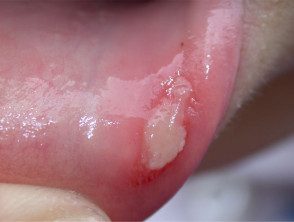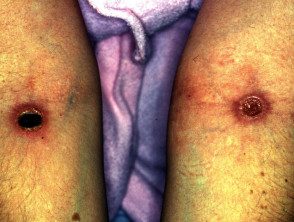What is Behçet's disease?
Behçet's disease (or syndrome) is a rare disease characterized by pain in the mouth ulcers, genital ulcers, eye problems and skin lesions. The condition is named after the Turk dermatologist Hulusi Behçet, who first described the disease in 1924. It is also known as Adamantiades-Behçet disease.
What causes Behçet's disease?
The cause of Behçet's disease is unknown, but it is presumed to be a autoimmune disorder: an individual's immune system begins to react against his tissues. The reason for this remains a mystery, but it is possible. bacterial or viral infection may have a role in their development.
Who is at risk for Behçet's disease?
Behçet's disease is the most common and most serious in people with lineages of the Silk Road. The countries of the Silk Road include those of the Mediterranean basin, the Middle East and the Far East; the incidence it is around 1 in 10,000 people. However, Behçet's disease is seen all over the world, even in those of other ethnic heritage; In the US, the incidence is reported to be 1 in 20,000.
In people of Silk Road descent, Behçet's disease is more common in men than in women. However, the trend is reversed with more women than men affected in people of other ethnic origins. The disease can develop at any age, but it is most common when people reach their 20s.–30 years.
What are the signs and symptoms of Behçet's disease?
Mouth ulcers (aphthous ulcers) are the most common and the earliest. sign of Behçet's disease. However, before they appear, a patient may experience a variety of recurrent Signs and symptoms including:
- Sore throat and tonsillitis.
- Muscle and joint pain
- Discomfort, generalized weakness
- Anorexia, weight loss.
- Headache
- Fluctuations in body temperature.
Painful mouth ulcers are usually the first outward sign of Behçet's disease and occur in approximately 70% of patients. Ulcers can occur anywhere in the mouth, including on the tongue and inside the lips and cheeks. They usually last 1 to 2 weeks, but can last up to three weeks.
Behcet's disease

Lip ulcer

Lip ulcer

Pathergy
See images of vulvar ulcers.
Other common signs and symptoms indicative of Behçet's disease include:
- Genital ulcers: These aphthous ulcers occur less frequently than canker sores. They are painful and generally heal with scars. They are not genital herpes, which is caused by the herpes virus.
- Ocular involvement: uveitis, which can redden and swell the eye tissue, can occur. The retina can sometimes be affected and, if left untreated, can lead to blindness.
- Skin lesionspainful nodules since erythema nodoso are common. Patients may also have acne-like sores that occur on the arms, legs, and trunk.
Less common symptoms include gastrointestinal problems (eg, abdominal pain, diarrhea, vomiting), joint pain and swelling, nervous system problems, and blood vessel and circulation problems.
How is Behçet's disease diagnosed?
Behçet's disease can be difficult to diagnose as signs and symptoms come and go and may not be apparent at one time. If you have a history of recurring mouth and genital ulcers, uveitis, and skin sores, this is indicative of the condition.
The international criteria for the classification of Behçet's disease define the conditions as:
At least three episodes of recurrent oral ulcers in 12 months plus at least two more of the following:
- Genital ulcers
- Ocular involvement (uveitis or retinal damage)
- Skin lesions
-
Positive pathergy test (this is a skin prick test that can confirm Behçet's disease)
There are no specific tests to confirm the diagnosis, but screening investigations such as blood count, kidney and liver function tests, and C-reactive protein It can be done to determine which organs are affected by the condition.
What is the treatment for Behçet's disease?
Currently, there is no cure for Behçet's disease. The main goal is to treat and control the symptoms so that complications do not develop. Because Behçet's disease affects many different parts of the body, a team of doctors from various specialties will treat most people.
Some medications that can help control symptoms include:
Current therapy
-
Tetracycline solution
- Topical corticosteroids
- Local anesthetics
Systemic therapy
- Oral corticosteroids
- Nonsteroidal anti-steroidsinflammatory medications (eg, aspirin, ibuprofen)
- Immunosuppressants (eg, Azathioprine, chlorambucil)
- Experimental and investigational drugs (for example, colchicine, cyclophosphamide, thalidomide, infliximab, and potassium iodide)
-
Apremilast, which has been approved by the Food and Drug Administration (FDA) in the US for oral ulcers in Behçet's disease
- A biological agent such as the TNF-alpha inhibitor, adalimumab.
Which is the forecast?
Behçet's disease is a chronic disease where the acute The phases come and go with varying degrees of intensity. In the early stages of the disease, attacks can be frequent and last for several weeks. As time passes, the intervals between attacks may become longer and, in some cases, the attacks stop completely. The disease is then considered to be in remission but he can hit again at any time.
Death occurs in approximately 4% of Behçet cases. Causes of mortality are attributed to gastrointestinal drilling, central nervous system involvement and vascular aneurysms (swelling of blood vessels)
Most of Behçet's patients live full lives, although they will most likely deal with some level of symptoms during this time.

